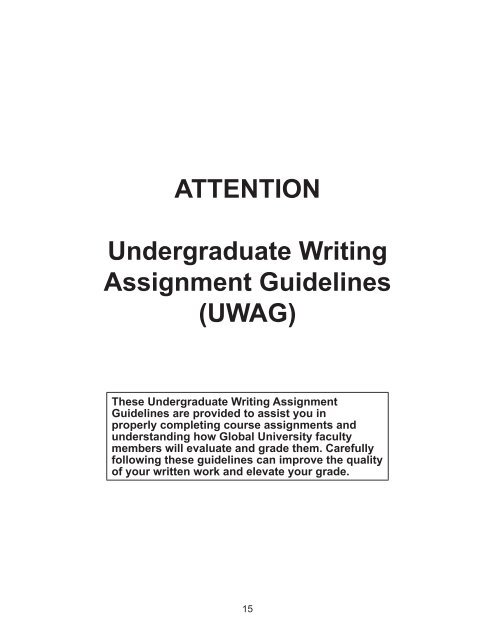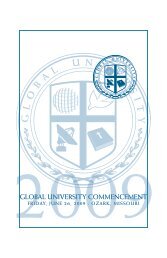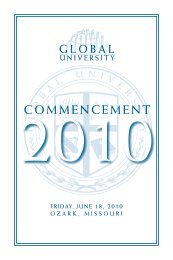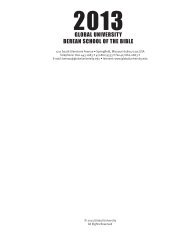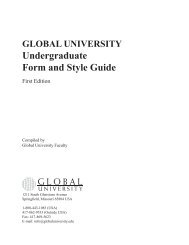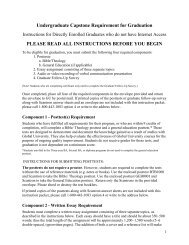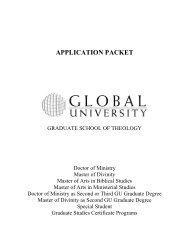UWAG - Global University
UWAG - Global University
UWAG - Global University
You also want an ePaper? Increase the reach of your titles
YUMPU automatically turns print PDFs into web optimized ePapers that Google loves.
ATTENTION<br />
Undergraduate Writing<br />
Assignment Guidelines<br />
(<strong>UWAG</strong>)<br />
These Undergraduate Writing Assignment<br />
Guidelines are provided to assist you in<br />
properly completing course assignments and<br />
understanding how <strong>Global</strong> <strong>University</strong> faculty<br />
members will evaluate and grade them. Carefully<br />
following these guidelines can improve the quality<br />
of your written work and elevate your grade.<br />
15
Undergraduate Writing Assignments (CRA and Project)<br />
Guidelines, Expectations, and Grading<br />
<strong>Global</strong> <strong>University</strong>’s Undergraduate Form and Style Guide defines the form, style, and documentation<br />
system for completing undergraduate writing assignments. The guide can be downloaded free from http://<br />
library.globaluniversity.edu/citation.cfm. The guide is also available as a stand-alone document.<br />
Writing for Academic Quality and Other Conceptual Issues<br />
● Follow instructions carefully. Failure to follow instructions will reduce the assignment grade.<br />
● Develop thoughts logically.<br />
● Do not merely repeat the author’s position—evaluate the author’s position.<br />
● You are encouraged to both agree and disagree with the authors of course materials. Explain why<br />
you agree or disagree.<br />
● Avoid using Hebrew, Aramaic, and Greek for most undergraduate CRAs and projects.<br />
● Write at a college level, using appropriate vocabulary, grammar, and spelling. Avoid using the<br />
second person (you). Avoid generalizations, idioms, and slang.<br />
● Consult reference works, including theological and Bible dictionaries, to accurately define terms.<br />
● Express concepts in your own words as much as possible. Document all quotations, paraphrases,<br />
and important ideas that are not your own, even if they are from course materials.<br />
● Clearly identify CRAs and projects on a title page.<br />
● Reference list. See Undergraduate Form and Style Guide documenting sources correctly.<br />
Grading<br />
This grading rubric represents a transition in grading guidelines for all <strong>Global</strong> <strong>University</strong><br />
undergraduate writing assignments. Note: Not all the following indicators may apply to a particular<br />
written assignment.<br />
Content and Organization 40% (8 points)<br />
Following instructions<br />
Organization of assignment and logical thought progression<br />
Subject matter content quality and accuracy<br />
Critical Thinking Skills 30% (6 points)<br />
Accurate understanding and evaluation of author’s position<br />
Statement of student’s position with supporting rationale<br />
Application and Research 20% (4 points)<br />
Appropriate plans for applying course concepts<br />
Contextualization of course concepts to the student’s culture or setting<br />
Inclusion of research using 3–5 references from the GU Library Web site<br />
or other academic sources<br />
Style, Grammar, Spelling, and Documentation 10% (2 points)<br />
Syntax (word choice and arrangement), spelling, and grammar<br />
Appropriate form and style, including source documentation<br />
TOTAL 100% (20 points)<br />
Scholarly Resources<br />
When writing course papers, students are asked to include 3–5 scholarly sources in their research.<br />
Generally, scholarly refers to original research found in books, magazines, and journals written by<br />
professional and credentialed experts. This is not to say that “popular” sources/authors cannot be<br />
used; however, such sources must be evaluated and found to be authoritative.<br />
Students may contact course faculty members for source evaluations, and a tutorial explaining the<br />
difference between “popular” and “scholarly” resources can be found on the GU Library Web site. To<br />
access the tutorial, go to Research Tools and click on Course Research Guides. Then, click on the<br />
course you are taking. Next, click on Information Skills. Finally, choose Popular vs. Scholarly<br />
Sources.<br />
17
To Ensure Your Assignment Is Graded Accurately<br />
1. Respond to questions and their subparts in the exact order they appear in the instructions.<br />
2. Type (or copy) each question and its number. Below it type (or write) your response.<br />
3. Respond to all components, clearly labeling and separating your answers to each. Your grader must be<br />
able to easily match responses to the corresponding component.<br />
General Directions<br />
Please type your CRA/Project using double-spaced lines. If you are unable to type your assignment, you<br />
may neatly write it with an ink pen, but DO NOT USE A PENCIL.<br />
Valuable resources for your writing assignment can be found in the various bibliographic lists at the back<br />
of your Study Guides or Independent-Study Textbooks (IST). Additional resources can be found by accessing<br />
the <strong>Global</strong> <strong>University</strong> Library Web site at http://library.globaluniversity.edu. Here you will find links to full-text<br />
journal articles in databases, reference articles in encyclopedias, other scholarly articles in Google Scholar, and<br />
Web sites with Web-based articles. Once you access the <strong>Global</strong> <strong>University</strong> Library Web site, you must log in<br />
with a user ID and a password in the upper right corner of the Web site. For your user ID, type in your <strong>Global</strong><br />
<strong>University</strong> student ID number. For your password, type in the first two letters of your first name, the first two<br />
letters of your last name, and the last four digits of your GU student ID number. (Use lowercase letters, do not<br />
type spaces within the password.) You may search on a topic and also browse by course title.<br />
Once you enter the <strong>Global</strong> <strong>University</strong> Library Web site, you can go to an Interactive Tutorial for<br />
instructions on how to use the databases on the Library Web site. You can also click on “Browse by Courses”<br />
and find links to Web resources appropriate to individual courses.<br />
Document any resources you use in course assignments (or other written work) according to <strong>Global</strong><br />
<strong>University</strong>’s Undergraduate Form and Style Guide. This style guide can be downloaded at the Web site, or you<br />
can contact the university to purchase a hard copy.<br />
Submitting Assignments<br />
Submit your assignments by e-mail attachment. Templates for the project and CRA are available for<br />
download from the <strong>Global</strong> <strong>University</strong> Web site: Library Resources for Undergraduate Students. If e-mail is not<br />
available, submit assignments by mail or fax.<br />
Terms<br />
The following definitions help you give a better answer to each inquiry within your CRA/project:<br />
● Analyze means to divide a complex whole into its individual components for the purpose of revealing<br />
how each works together and contributes to the whole.<br />
● Apply means to put, or to show how to put, specific principles or concepts to practical use.<br />
● Compare means to identify similarities.<br />
● Contrast, differentiate, and distinguish mean to identify differences.<br />
● Critical thinking is a reflective and systematic process in which you gather information, study it from<br />
every angle, and then exercise your best judgment to draw conclusions.<br />
● Describe, discuss, and explain mean to give details, examples, illustrations, implications, and/or<br />
reasons to support your answer.<br />
● Evaluate means to determine the significance, worth, or condition of something by careful study.<br />
This includes identifying the strengths and weaknesses of whatever is being evaluated, whether it is a<br />
concept, principle, application, idea, event, opinion, object or product.<br />
18
Quick Guide to Referencing<br />
Q Where do I document sources—inside the paper or at the end of the paper?<br />
A Both. Author, date of publication, and page number must be included as parenthetical references within the<br />
text. Titles are not listed in the parenthetical references. A reference list at the end of the paper should list<br />
full publication details. Page numbers are not included in the reference list.<br />
Book in Print<br />
In-Text Documentation<br />
When quoting from a book, quotation marks are required at the beginning and end of the quotation.<br />
Immediately after the quote and before ending punctuation, insert a parenthetical reference including author’s<br />
last name, most recent date of publication, and page number(s).<br />
Biblical context is one of the key factors in interpreting Scripture correctly and there are “three kinds of context:<br />
immediate context, remote context, and historical context” (Arnold & Beyer 1999, 29).<br />
A quote longer than four lines is single spaced without quotation marks and indented from the left margin.<br />
Insert a parenthetical reference at the end of the quote, following ending punctuation.<br />
Note the verbs describing God’s concern: I have seen . . . have heard . . . I am concerned . . .I have come down.<br />
Three of the verbs with God as subject are repeated from 2:24–25 (see, hear, know), with a closer specification as<br />
to just what it is God sees and knows. God truly sees their affliction. God knows their sufferings. For God to know<br />
the people’s sufferings testifies to God’s experience of this suffering, indeed God’s intimate experience. God is here<br />
depicted as one who is intimately involved in the suffering of the people. (Fretheim 1991, 36)<br />
When the author’s name is stated in the text, the parenthetical reference lists only the date and page number<br />
(the author’s name is not repeated).<br />
Arnold & Beyer note that there are “three kinds of context” (1999, 29). or<br />
Arnold & Beyer (1999, 29) note that there are “three kinds of context.”<br />
Reference List Documentation<br />
Works used in the paper are also listed at the end of the paper in the reference list.<br />
Arnold, Bill T. & Bryan E. Beyer. 1999. Encountering the Old Testament. Grand Rapids, MI: Baker Book House.<br />
NOTE: In this referencing system, only works actually cited in your paper are to be included in the reference<br />
list. (See the <strong>Global</strong> <strong>University</strong> Undergraduate Form and Style Guide 2010, page 7.)<br />
Book on the Internet<br />
In-Text Documentation<br />
A full book accessed from the Internet is referenced in the text the same as a printed book.<br />
Scripture attributes varying ministries to each person of the Trinity. “The different functions that we see the Father,<br />
Son and Holy Spirit performing are simply outworkings of an eternal relationship” (Grudem 1994, 251).<br />
Reference List Documentation<br />
In the reference list, both the Web site and date of access are listed after the other information.<br />
Grudem, Wayne A. 1994. Systematic Theology: An Introduction to Biblical Doctrine. Grand Rapids, MI: Zondervan.<br />
http://books.google.com/books (accessed February 2, 2006).<br />
Consult the GU Undergraduate Form and Style Guide for other examples (journal or magazine articles, books<br />
with more than one author, etc.).<br />
19
Cover and Page Design<br />
Example cover pages for your Project and CRA are included in this packet. It is very important that<br />
you place your name, student number, course number, course title, course PN (located on the copyright<br />
page), and page number at the top of each additional page (see sample pages below). You are required to<br />
clearly mark each part of the answer. Be sure to write legibly, using a computer printer, typewriter, or pen.<br />
DO NOT USE A PENCIL.<br />
SAMPLE PROJECT COVER PAGE SAMPLE CRA COVER PAGE<br />
PROJECT TITLE<br />
By<br />
Your Name<br />
Student Number<br />
A Project<br />
Submitted to the Faculty<br />
In Partial Fulfillment of the Requirements for<br />
Course Number<br />
Course Title, Edition<br />
Course Print Number<br />
<strong>Global</strong> <strong>University</strong><br />
Month Year<br />
20<br />
CRA TITLE<br />
By<br />
Student Name<br />
Student Number<br />
A Collateral Reading Assignment<br />
Submitted to the Faculty<br />
In Partial Fulfillment of the Requirements for<br />
Course Number<br />
Course Title, Edition<br />
Course Print Number<br />
COLLATERAL READING ASSIGNMENT<br />
TEXTBOOK:<br />
CRA Textbook Title<br />
by CRA Textbook Author<br />
Publisher Location: Publisher Name, Year<br />
<strong>Global</strong> <strong>University</strong><br />
Month Year<br />
SAMPLE SECOND PAGE SAMPLE THIRD PAGE<br />
Student Name, Number Course Number, Title, Print Number<br />
Part 1<br />
Project/CRA Title<br />
...........................................................................<br />
...........................................................................<br />
...........................................................................<br />
...........................................................................<br />
...........................................................................<br />
...........................................................................<br />
...........................................................................<br />
...........................................................................<br />
...........................................................................<br />
...........................................................................<br />
...........................................................................<br />
...........................................................................<br />
...........................................................................<br />
2<br />
Student Name, Number Course Number, Title, Print Number<br />
...........................................................................<br />
...........................................................................<br />
...........................................................................<br />
...........................................................................<br />
...........................................................................<br />
...........................................................................<br />
...........................................................................<br />
...........................................................................<br />
...........................................................................<br />
...........................................................................<br />
...........................................................................<br />
...........................................................................<br />
...........................................................................<br />
...........................................................................<br />
3


